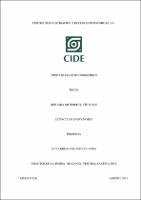| dc.contributor.advisor | Dr. Daniel Ventosa-Santaulària |
| dc.creator | Verduzco Bustos, Guillermo |
| dc.date.issued | 2016 |
| dc.identifier | 152739.pdf |
| dc.identifier.uri | http://hdl.handle.net/11651/2482 |
| dc.description.abstract | The present study analyzes two topics in macroeconometrics: the first one is on the power of the Dickey and Fuller (1979) test and, the second one, about inference issues because of aggregation and smoothing methods in macroeconomics. The first topic is focused on the analysis of the asymptotic properties of the Dickey-Fuller test under the alternative hypothesis of stationarity. Punctually, we studied the power of such test, this is, the probability of not making a type-II error (accepting the null hypothesis when it is false). We analyzed the limit behavior of the Dickey-Fuller test under the alternative hypothesis of stationarity. Through a Monte-Carlo experiment, we were also able to study its finite sample behavior as well as its dynamics when the sample size grows. Then, we proposed reporting the power in a similar way in which the size is reported to obtain the relevant properties of the t-ratios of the estimated parameters of the test. The second topic analyzes the aggregation and smoothing methods on macroeconomics. Under standard conditions, i.e., under stationarity, the social scientist would be able to draw inference using test statistics. The t-ratios associated with estimated parameters, for example, are widely used in applied economics. Asymptotically, this statistic converges to the normal distribution under the null hypothesis. This means that the practitioner would use critical values derived from a standard normal distribution. However, using Phillips’ (1986) theoretical setting, we show that the distribution of the t-ratio associated with the coefficient for a regression that uses aggregated variables does not converge to a standard normal, but remains centered at zero; its tails are narrower than those of the standard normal. Hence, the critical values traditionally used are incorrect in the inferential analysis of the regression: The econometrician may over-reject the null hypothesis and the inference is misleading. |
| dc.format | application/PDF |
| dc.language.iso | eng |
| dc.publisher | El Autor |
| dc.rights | Con fundamento en los artículos 21 y 27 de la Ley Federal del Derecho de Autor y como titular de los derechos moral y patrimonial, otorgo de manera gratuita y permanente al Centro de Investigación y Docencia Económicas, A.C. y a su Biblioteca autorización para que fije la obra en cualquier medio, incluido el electrónico, y la divulguen entre sus usuarios, profesores, estudiantes o terceras personas, sin que pueda percibir por tal divulgación una contraprestación. |
| dc.subject.lcsh | Macroeconomics. |
| dc.subject.lcsh | Monte Carlo method. |
| dc.title | Topics in macroeconometrics |
| dc.type | Tesis de licenciatura |
| dc.accessrights | Acceso abierto |
| dc.recordIdentifier | 000152739 |
| dc.rights.license | Creative Commons Reconocimiento-NoComercial-SinObraDerivada 4.0 Internacional CC BY-NC-ND |
| thesis.degree.grantor | Centro de Investigación y Docencia Económicas |
| thesis.degree.name | Licenciatura en Economía |
| dc.relation.dataset | http://www.ventosa-santaularia.com/NP_database.html |


